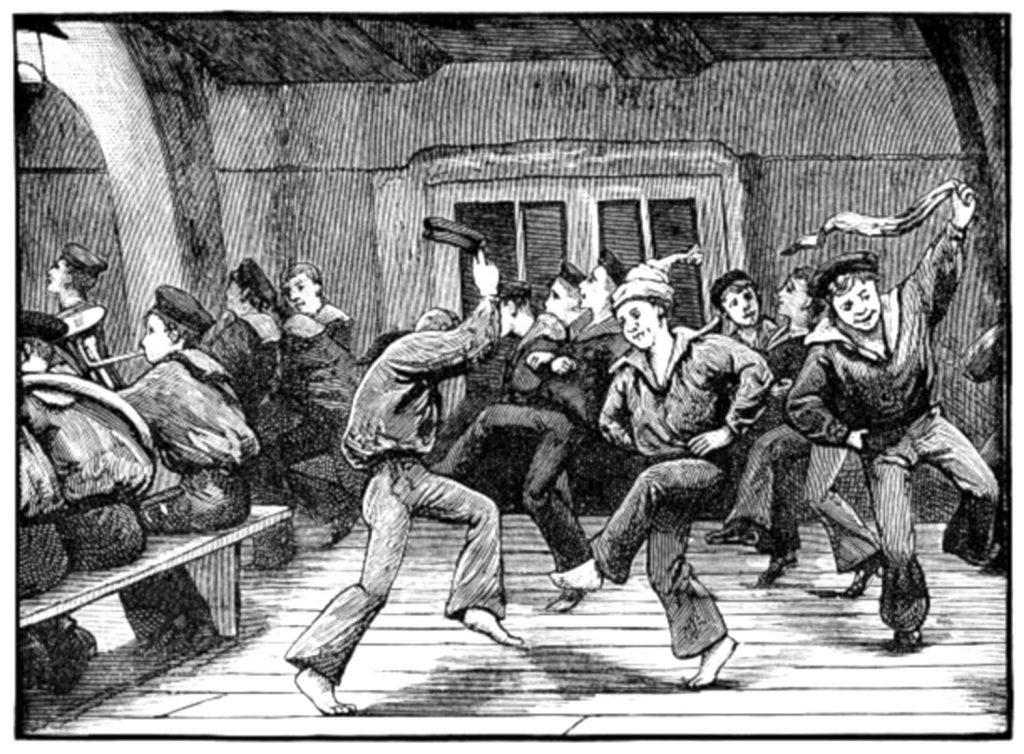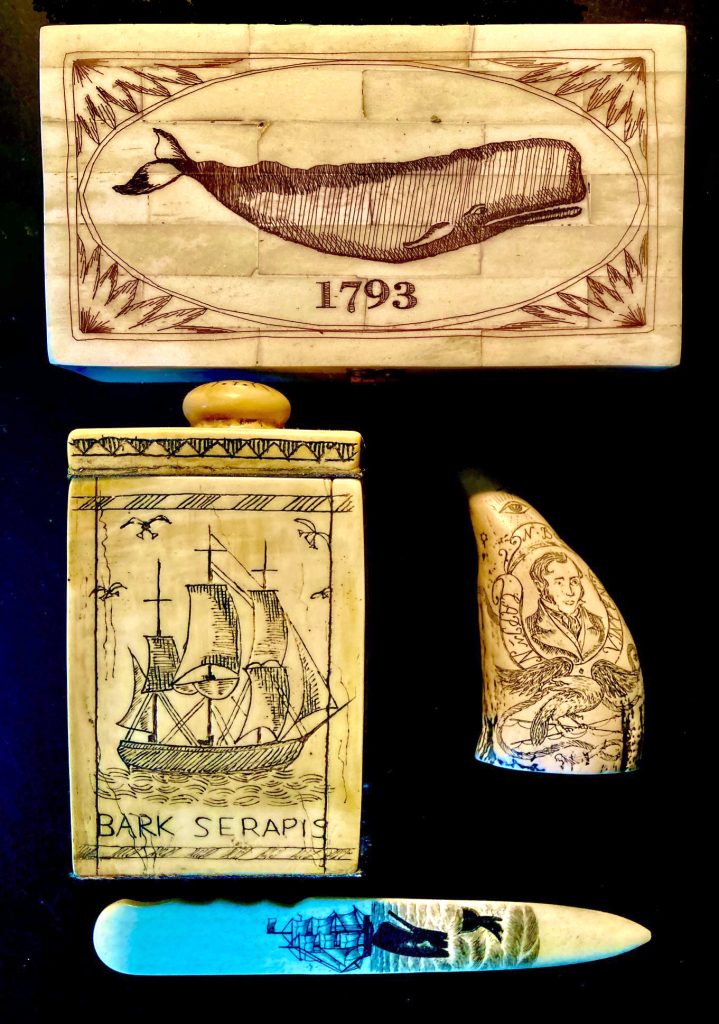Music, art, and song are woven into the canvas of sailing vessels.
What did the sailors that manned the war, trade, whaling and fishing ships during the age of sail do to occupy themselves on the few hours they had to themselves?
Every sailor aboard kept several knives for his use and safety. They were very adept at carving items for use on the ship, as items for trade in the countries they sailed to, and as gifts for loved ones when they finally came home from voyages that could last years. Sometimes they would carve or engrave ivory whales’ teeth, baleen and bone to make combs, knives, and sword handles. The most talented sailors would carve jewelry and hair decorations for their lovers back home and for their additional lovers at every port they visited. (You get the picture, or do I have to spell it out for you?) Trinkets and jewelry boxes took a long time to carve. Those were saved to bring home in most cases. Many times, engraved parts were finished off with black ink rubbed into the carvings to make them stand out. They were also talented in carving exotic woods they found in exotic lands. Sailors would also make toy-like fabrications to amuse themselves. They were not averse to making their own dice to gamble with and I guarantee, if they could “weight” them, they did at the risk of disappearing overboard if caught.

What would a sailor be without his own yarns to tell? Sailing was 50% boredom and 50% adventure and danger. There was a great comradely amongst sailors. Their lives depended on it. When work eased and they received their daily allotment of “grog”, which was a standard of the times, their tongues would begin to wag, and stories whiffed through the salt air. Truth rarely factored in these tales. The more years a man sailed the seas, the more time he had to finesse his tales. With most of these stories, the scarier the better. If they bruised a sailor’s superstitious nature, better yet! It should be noted that during the age of sail much of the world was just beginning to be explored. New cultures were being found and wild animals were discovered. Remember this; the great white shark was first identified in 1758. What tales of a giant shark or a “Kraken” (Giant squids have only recently been verified by science) could be spun? The first silverback gorilla was discovered in 1902, only 30 years before “King Kong” was filmed. (Released in 1933). So, you can imagine the tales’ sailors, fishermen, and pirates, having visited uncharted seas and exotic wild places, could cook up to spook their mates as they tried to get some shuteye below deck in their hammocks. (I don’t think I will be getting much sleep myself tonight.)
So, you’re a sailor who spent the night, eyes wide open, because “matey Ol’ Danny Boy” gave you insomnia with his Creep Show Stories. What do you do? At “Grog” time, you and the rest of the crew not on duty reach into your handmade canvas gunny sacks and pull out their musical instruments. Some are even handmade by the sailors themselves. One chap has his concertina (small accordion) another mate pulls out a penny whistle. And so it goes as a fiddle, banjo, flutes, ukulele, and tambourine all appear. One crewman starts clacking spoons together to start the concert. They all join in playing their favorite reels they learned growing up and perfected by practicing with their other mates on many long voyages. Crews were very diversified. Yankees, English, Irish, Portuguese, Spanish, Free Afro-Americans, Native Americans, etc. all would join in making their music rich with their heritage. Other crewmen might jump up and start dancing to the music adding to the merriment.
Shortly the music changes to sea chanteys and songs then musicians and crew break out singing. Chanteys were originally sung out to keep rhythm when the crew had to pull the anchor up. Songs like “Paddy Dyles Boots, Fair Well and Away, Heave Away Boys, Eddystone Light, Santiago, and Sloop John B.” were among the many favorites. It was a fun way to pass time. However, certain songs like “Danny Boy” could remind a sailor of home and loved ones and almost bring a tough sailor to tears. Sea chanteys and nautical songs are kept alive by musicians who are dedicated to keeping this music alive. You can find them at Mystic Seaport, New Bedford Mass., and along the waterfronts along our coasts.

One famous folk singer, Pete Seeger, spent his life keeping maritime songs and other traditional folk music alive. Pete built the sloop Clear Water that continues to sail up and down the Hudson River often with sea chantey folk singers aboard. Canvas was the propellant of every great sailing ship. A crewman had to know how to sew and patch canvas sails. They also used off time to sew their own canvas storage bags with rope (line) closures. They would also patch their own clothing, often decorating them with scrap pieces of colorful cloth and ornate stitching. Although sewing may not sound “Nautical Tuff”, You can bet that these rough and tough crewmen, who could bend me and you in two, found sewing to be a satisfying break from climbing masts, swabbing decks, tarring lines, setting and lifting anchors, furling and unfurling sails, on and off-loading cargo and killing roaches and rats. (All sailing ships were infested)
Now we come to an art form that originated in Arabia and spread to crews on sailing ships. Most folks don’t realize it started there. It was a craft craze almost 50 years ago in the early 1970s. I was much too young to remember it but my neighbor “Danny D’’ on Oak Island N.Y. told me about it. MACRAME! That’s it! Macrame! When you were onboard a sailing ship in the 18th and 19th centuries, you were surrounded by ropes! Officially called “Lines” on a vessel. So, what did bored sailors do? They weaved, knotted, and tied lines in elaborate patterns making everything from floor mats to wheel handle sleeves, belts, ships bell clacker extensions, decorative carry bags, hammocks and other beautiful decorative pieces. They were a popular item to trade especially in the Orient. I know this craft is coming back as I just saw I guy with a Harley who had made his own macrame seat cover. As I went to touch it, he said “Hey! Don’t touch that! I made it myself! I break your ———— fingers! I turned and began to sing a sea chantey as I ran away!
Now you know that the sailors during the height of the age of sail weren’t the typical “Yo ho! Yo ho! deadbeats they were often portrayed as. They had many talents. Some even kept written and illustrated diaries of their adventures. The abilities of those sailors of yesteryear went far beyond the duties they signed on for. Today there are many living museums where you can see and hear the magical creativity, they gave to all of us.
C. 2022 by Mark C. Nuccio All rights reserved
Contact Mark – mark@designedge.net
